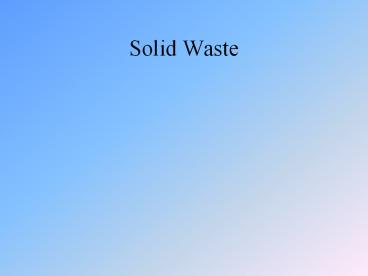Solid Waste - PowerPoint PPT Presentation
1 / 32
Title: Solid Waste
1
Solid Waste
2
Consumption for Average U.S. Citizen over a 70
year life span
- 623 tons coal, oil, natural gas
- 613 tons sand, gravel, stone
- 26 million gallons of water
- 21,000 gallons of gasoline
- 51 tons of metals
- 50 tons of food
- 48 tons of wood
- 19 tons of paper
- 5.2 tons of syn. Plastic, rubber, fibers
- 5 tons fertilizer
3
Waste for Average U.S. Citizen over a 70 year
life span
- 840 tons of agricultural waste
- 823 tons of garbage, industrial mining wastes
- 7 million gallons polluted water
- 70 tons of air pollutants
- 19,250 bottles
- 19,000 cans
- 7 automobiles
4
Major categories of U.S. Solid Waste
Agricultural Waste Mining Waste Industrial
Waste Municipal Waste
5
Major categories of U.S. Solid Waste
Agricultural Waste 56 Mining Waste 34
Industrial Waste 6 Municipal Waste 4
6
Components of Agricultural Waste
- Crop residues anything that is not harvested
and used for food, fiber or energy - Animal wastes includes manures and carcasses
- Pesticide Herbicide residues
- Old equipment and fuel residues
7
How can these be disposed of?
- Crop residues composting, plowing into the soil
(increases organic matter), or burning - Animal wastes composting, fertilizers,
pyrolysis - Heating under very high temperatures and
pressures to get oil - Other wastes are landfilled or disposed of in situ
8
Components of Mining Waste
- Tailings!
9
Why are there so many tailings
- When you find the ore you are interested in, it
will be combined with other rocks, not as pure
form. - After you dig up the raw ore, it is pulverized
and the material of interest is extracted,
leaving behind the tailings - The purest ore that is found is taconite, a form
of iron. Its concentration is 30, leaving 70
tailings! - Most ores contain 1 or less of the material of
interest.
10
Why are there so many tailings, continued
Strip mines make even more tailings than
under- Ground mines.
Left over soil can become tailings here along
with Mining waste.
11
Legislation and efforts to reclaim mining areas
- 1977 Surface mining control and reclamation act
(one of the first efforts) - Land must be restored to its original contours
and use - Mining banned on prime agricultural land
- Effects on local watersheds must be minimized
12
What can be done with tailings?
- Because of their thin, powdery nature, this is
tricky also contaminated with heavy metals such
as lead, zinc, cadmium, etc. These are toxic. - Ceramics especially high temperature tiles for
furnaces - Road surface materials
- Building materials (e.g. concrete blocks)
13
What can be done with tailings?
- Only specific tailings can be used for a specific
purpose due to their complex chemistry. - Some tailings can contain radioactive compounds
like radon and must therefore be used with
extreme care!
14
Components of Industrial Waste
- This is where we think of things such as chemical
waste, toxic wastes, etc. - The EPA estimates that only 10 of toxic wastes
are disposed of properly. - Some of these wastes are getting into local
drinking water supplies, food supplies, and
ecosystems..
15
The Love Canal Story
16
1927
Arrow Shows Canal Location
17
History of Love Canal
- 1942 1952 Hooker Chemical dumped 21,000 tons of
chemicals in the old canal in steel drums and
then covered them with fill dirt. - This was legal at the time.
- 1953 Hooker forced to sell canal area to Niagara
School Board for 1! - Did so under duress stated that canal area was
NOT safe! - School board had several realtors on it.
18
History of Love Canal
- Between 1953 and 1977 an elementary school and
239 homes were built on or near the canal,
followed by a major subdivision of 710 homes - 1977 extremely heavy rains chemicals start
leaching into basements - In the meantime the area had higher than normal
rates of cancers and birth defects
19
1980
Canal
Note homes built next to and near canal.
20
History of Love Canal
- 1978 residents evacuated from canal area after
over 200 different compounds are found - New York State spends 37 million relocating the
239 families closest to canal - Federal government relocates the remaining 710
families - RCRA begins
21
Superfund sites in Oklahoma?
22
You Betcha!
- Look at the handout
- Go over the flow chart
23
Municipal Wastes
24
(No Transcript)
25
Municipal Wastes
- These can also be hazardous!
- Therefore, as of October 9, 1993, solid waste
facilities will be constructed as
Methane collection system
26
How else can municipal waste be disposed of?
- Incineration
- Waste to energy programs
- Burn waste and generate steam to power an
electric power plant - Burn methane from waste in city vehicles or to
make electricity
27
Reduce, Reuse, Recycle
- Since waste in the U.S. is primarily paper, a
large proportion of it can be recycled - If it not contaminated with food or covered with
the clay-based inks seen in shiny magazines,
etc. - With the amount of yard waste in Norman being
reduced by the compost facility, citizens get a
rebate from state government on their bill every
month
28
See steady increase in steel cans recycled
29
Also see steady increase in bottle recycling
30
(No Transcript)
31
(No Transcript)
32
(No Transcript)































